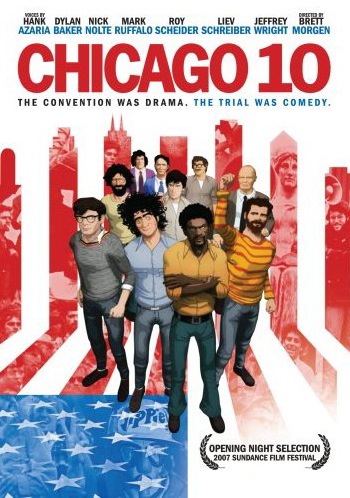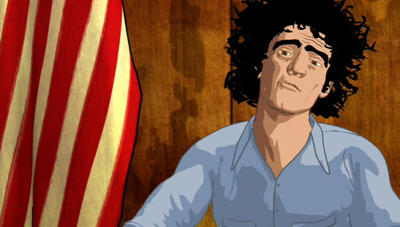| Release List | Reviews | Price Search | Shop | Newsletter | Forum | DVD Giveaways | Blu-Ray/ HD DVD | Advertise |
| Reviews & Columns |
|
Reviews DVD TV on DVD Blu-ray International DVDs Theatrical Reviews by Studio Video Games Features Collector Series DVDs Easter Egg Database Interviews DVD Talk TV DVD Talk Radio Feature Articles Columns Anime Talk DVD Savant HD Talk Horror DVDs Silent DVD
|
DVD Talk Forum |
|
|
| Resources |
|
DVD Price Search Customer Service #'s RCE Info Links |
|
Columns
|
 |
Chicago 10 |

|
Chicago 10 Paramount 2007 / Color / 1:85 anamorphic widescreen / 90 110? min. / Street Date August 26, 2008 / 29.98 Starring voices of Hank Azaria, Dylan Baker, Nick Nolte, Roy Scheider, Liev Schreiber, Jeffrey Wright Film Editor Stuart Levy Original Music Jeff Danna Produced by Graydon Carter, Brett Morgen Written and Directed by Brett Morgen |
Chicago 10 reintroduces a documentary device that was used as far back as the Spanish American War, when filmmaker J. Stuart Blackton filmed model boats in a tub to yield scenes of the battleship Maine being sunk in Havana. John Ford faked scenes of the attack on Peal Harbor for his wartime documentaries; many of his shots are still being confused for authentic news footage. Director Brett Morgen, known chiefly for his animated graphics phantasmagoria The Kid Stays in the Picture, uses various forms of animation in Chicago 10, mainly to present scenes from the trial of the Chicago 10 (or 7, or 8) where no cameras were allowed. Thus Morgen is able to inter-cut actual news footage of the run-up to the Chicago Democratic Convention of 1968, with a reasonably accurate account of the show trial of the supposed 'revolutionary ringleaders' more than a year later.
The effect is sometimes crude, but it works. As ever with this subject, the most difficult thing to believe is the farcical nature of the trial, with a near-senile judge openly siding with the prosecution and at all times presuming that the defendants are guilty.
Chicago 10 digs into excellent resources of news film on the infamous Chicago Democratic Convention, much of it in color and all of it highly effective. We see bits of news reports as well as CBS News tape of action inside the convention hall. In short, a coalition of anti-war activist organizations, including the Yippies, decided to use the convention to dramatize their opposition to the ongoing war in Vietnam. Activists like Tom Hayden, David Dellinger, Abbie Hoffman and Jerry Rubin applied for permits to stage protests and were turned down; Mayor Richard J. Daley was determined to see that demonstrators were repelled and called out riot police and the National Guard to "maintain order." Aware of the military build-up and galled by Mayor Daley's attempts to control the news coverage, CBS anchor Walter Cronkite calmly states on camera that, "Chicago has become an armed camp."
As seen in the prime-source news film, the week's events were guaranteed to polarize reactions and divide the country. The demonstrators did not accept being denied the right to protest, and to circumvent an outright ban initially called their gathering a music festival. The organizers were a mixed bunch. Staunch anti-War activist David Dellinger looked like a lawyer, wore a tie and gave firm but unyielding interviews. Much of the media attention went to the longhaired and profane Abby Hoffman. Hoffman turned permit request meetings into rude guerrilla theater. The crowds that gathered in Lincoln Park were mostly ordinary young people and not that many hippie types, but part of organizer Abby Hoffman's strategy was to turn the demonstrations and expected clashes into a political circus. Television coverage insured that America received the impression that the animals had taken over the zoo. Any image of the "concerned, patriotic war dissenter" now became the "insolent profane longhair radical," something that both popularized and stigmatized the anti-War effort. Being against the war was equated with being an unkempt, un-housebroken Commie.
As for the opposition, Chicago authorities plain didn't recognize the right of peaceful protest. Vietnam was called the Democrats' War and the only candidate who promised peace had been assassinated earlier in the year. When the demonstrators ignored the police, claiming that their right to protest superceded the assembly and curfew laws, the clash was on. Finally, three nights into the siege, the protesters tried to leave the park and march to the assembly hall. The police halted their lines, deployed their forces and then attacked with clubs. Live images from the street interrupted the network convention coverage, and all of America was able to see the police riot. Those disposed to take the side of the police figured that the bum protesters got what was coming to them. Americans disenchanted with the war and the climate of violence and assassinations saw the incident as political oppression.
Chicago 10 inter-cuts the excellent news film of the action in August of '68 with the March 1969 trial of the Chicago Seven. The defendants were accused of conspiracy and inciting to riot, even though much of the country felt that it would be more appropriate to try Mayor Daley and his Chicago police on the same charges. Later study of the Nixon administration has given credence to the idea that Nixon had Attorney General Mitchell order the trial to go forward against legal advice, to punish and discredit the anti-War movement in general.

Rendering the un-filmed trial as animation is much more effective and valid than it may seem. The transcripts of the trial have already been dramatized in plays. The animation is accomplished with motion-capture technology, which yields an aesthetically neutral look to the proceedings. In other words, the characters haven't been stylized to show preference for one side or another. Abbie Hoffman looks as scruffy as ever -- his hair is rendered as a ragged ink-nest -- and nobody's looks have been exaggerated or caricatured. Judge Hoffman can't remember anybody's name and must be continually corrected. He allows the prosecution to call the defendants whatever they want, and shoots down every defense motion. The film's tagline is, "The convention was drama. The trial was comedy", and viewers unacquainted with the history may have difficulty believing what they see.
Perhaps hoping to make the trial into a precedent-setting pre-emptive strike against the entire counterculture, the prosecution chose to try Bobby Seale of the Black Panthers as well, even though he was in Sweden during the convention. Unlike his co-defendants, Seale insisted on separate counsel or defending himself and would not be silenced; Judge Hoffman had him chained to his chair and gagged. Seale's case was eventually split off, leaving the other seven defendants alone. Abby Hoffman referred often to the case as the "Chicago Ten" because he felt that the two defense lawyers were as much on trial just as were the activists. Hence the varying historical references to the number of defendants as 7, 8 and 10.
Chicago 10 has little or no voiceover and instead makes its points through seldom seen archive film, reformatted for widescreen and possibly digitally enhanced. The TV coverage of the riots, for instance, is clearer than I've ever seen it before. Interestingly, the strongest images don't put the protesters in the best light. The crowds acting up in the Park look like silly Kindergartners playing "take the hill" and forcing the cops to drag them from a statue. Taking off at nights during the trial to give speeches, the defendants do indeed seem to be gilding their own images as much as advancing their cause. Abby Hoffman is funny, but can only be considered a detriment to the greater anti-War movement. Purposely turning every situation into a silly circus, Hoffman isn't the kind of leader one wants to face riot police with.
On the other side of the fence, the cops are very, very scary. Asked to elaborate on his instructions, a police commander bluntly tells the protesters that they will not proceed on their march, as if mentally loading bullets into his guns. It was the Ohio National Guard that opened fire on American student protesters, but these Chicago cops look very prepared to do the same.
Brett Morgen's partly animated docu is good history ... accurate, legit and entertaining. It's clearly made to honor the anti-War protesters, but our parting impressions are definitely not so simple.
Paramount's disc of Chicago 10 is a fine enhanced encoding of this Sundance-screened show (where it may have been 20 minutes longer) that received a very limited release in 2007. The quality is excellent, and it's worth mentioning that the "dirty" look of the very opening titles is intentional. Most of the animation is not there for its own sake but to enable a visual presentation of the trial transcripts; the best thing about the animation is that the personages rendered in digital ink inter-cut smoothly with their real-life news film counterparts. Recommended.
On a scale of Excellent, Good, Fair, and Poor,
Chicago 10 rates:
Movie: Very Good / Excellent
Video: Excellent
Sound: Excellent
Supplements: Video Remix
Packaging: Keep case
Reviewed: August 24, 2008
Reviews on the Savant main site have additional credits information and are more likely to be updated and annotated with reader input and graphics.
Review Staff | About DVD Talk | Newsletter Subscribe | Join DVD Talk Forum
Copyright © MH Sub I, LLC dba Internet Brands. | Privacy Policy
Subscribe to DVDTalk's Newsletters
|
| Release List | Reviews | Price Search | Shop | SUBSCRIBE | Forum | DVD Giveaways | Blu-Ray/ HD DVD | Advertise |





